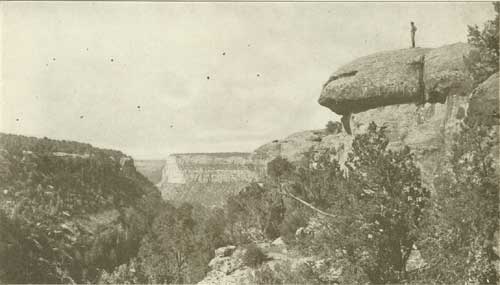|
NATIONAL PARKS PORTFOLIO
|
THE MESA VERDE NATIONAL PARK
CITIES OF THE PAST
 NE December day in 1888 Richard and Alfred
Wetherell, searching for lost cattle on the Mesa Verde, near their home
at Mancos, Colorado, pushed through dense growths on the edge of a deep
canyon and shouted aloud in astonishment. Across the canyon, tucked into
a shelf under the overhanging edge of the opposite brink, were the walls
and towers of what seemed to them a palace. They named it Cliff
Palace.
NE December day in 1888 Richard and Alfred
Wetherell, searching for lost cattle on the Mesa Verde, near their home
at Mancos, Colorado, pushed through dense growths on the edge of a deep
canyon and shouted aloud in astonishment. Across the canyon, tucked into
a shelf under the overhanging edge of the opposite brink, were the walls
and towers of what seemed to them a palace. They named it Cliff
Palace.
Forgetting the cattle in their excitement, they searched the edge of the mesa in all directions. Near by, under the overhanging edge of another canyon, they found a similar group, no less majestic, which they named Spruce Tree House because a large spruce grew out of the ruins.
Thus was discovered the most elaborate and best-preserved prehistoric ruins in America, if not in the world.
A careful search of the entire Mesa Verde in the years following has resulted in many other finds of interest and importance. In 1906 Congress set aside the region as a national park. Even yet its treasures of antiquity are not all known. A remarkable temple to the sun was unearthed in 1915.

|
|
GOVERNMENT ROAD TO THE CELEBRATED PREHISTORIC RUINS Showing the woods which justify the title Mesa Verde (Green Mesa) |

|
| YESTERDAY AND TO-DAY |

|
|
THE MESA VERDE, OR GREEN MESA, IS SO CALLED BECAUSE COVERED WITH CEDAR
AND PINYON TREES IN A LAND WHERE TREES ARE FEW Photograph by J. L. Nusbaum |

|
|
ABOVE THE BROKEN ROCKS, OR TALUS, RISE PRECIPITOUSLY THE CLIFFS UNDER
WHOSE OVERHANG THE CLIFF DWELLINGS NESTLE Photograph by J. L. Nusbaum |
| <<< Previous | <<< Contents>>> | Next >>> |
yard1/meve1.htm
Last Updated: 30-Oct-2009